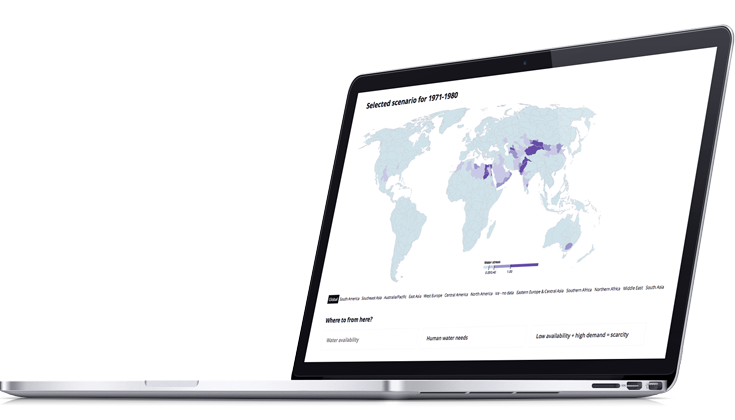What should you do?
There are a broad range of actions that can alleviate water scarcity. There is no such thing as a free lunch, there will always be flow-on consequences. When everything is changing, it’s important to think about what lines you should avoid crossing.
Featured analysis
Irrigation and, more generally, agriculture are the biggest water users in most parts of the world, with a large part of this going to food production. There are several widely recognised ways in which water use could be reduced, while still providing healthy food for all.
The futures exploration tool in the Atlas provides a preliminary estimate of the combined impact of several measures at a local scale, based on an analysis by Kummu and others in 2017. This includes:
- Diet change: avoiding overeating, and eating less animal products (which require substantial water for feed)
- Reducing food loss and waste
- Yield gap closure, producing more crops with limited changes to water use
- Benefiting from trade: some places can produce food with lower water use and lower impacts on water scarcity.
If less food needs to be produced, and it is produced with less water (higher efficiency/higher productivity), the total water use for agriculture can be reduced, improving water scarcity.
Key assumptions and limitations:
The article by Kummu and others emphasises that a lot of work is still needed to get a reliable understanding of impacts of changes to the system. We hope to add more on these issues to the Atlas over time.
- Some of the changes we are exploring are large enough that many things would need to change in how the world works. Impacts are difficult to predict, and it is even more difficult to know whether the new situation will actually be sustainable and fair.
- As it stands, the measures interact with each other in ways that have not yet been captured well enough – the combined impact may be higher or lower than estimated. This work is at a very early stage.
- There are important food sources that have not yet been included in the analysis, for example, fish. Innovations like precision farming, bioengineering, vertical farming and artificial meat could also have substantial impacts.
- Climate change has quite wide ranging effects – currently we only look at a few scenarios of changing water availability, and how water needed for irrigation might change.
- There are gaps in our knowledge of the food value chain, e.g. regarding how food losses can be reused. More generally, assumptions in different parts of the analysis are not yet fully harmonised.
- Trade and international relations play a very important role in how impacts of food production are distributed globally, that needs to be further explored.
- We only look at “what if” these changes happened, not yet at how feasible it is to achieve them, or who would be involved.

Dig deeper!
Explore this data in a full interactive visualisation - change assumptions and explore possible futures!
What should you do?
Water scarcity means it is difficult to satisfy everyone. Reducing your own (direct & indirect) water use can help, but it’s important to think about the impacts in the whole system when trying to solve this problem.
Further reading
- Futures exploration tool
- Bringing it all together
- Publications on reducing water scarcity
Submit a topic?
Have you done research related to water scarcity? Send us some information and we may publish your research in the Water Scarcity Atlas. Please email us at info@waterscarcityatlas.org
Feedback
Want to give us a feedback? Send us an email at info@waterscarcityatlas.org